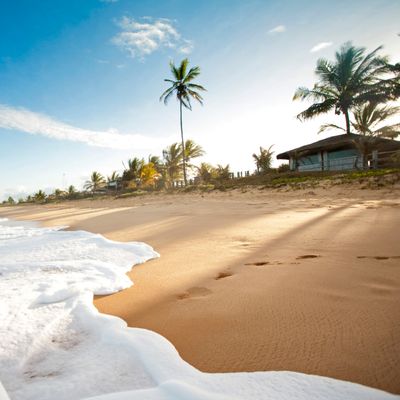
It’s probably not surprising that two of the most popular domestic-tourism spots for American travelers last year were California and Florida, states known for — among other things — their beaches. A beach getaway is a blank canvas of a trip, a destination that can be shaped in wildly different ways: Families get their sandcastle-and-Sno-cone wholesomeness; partygoers get their spring-break rowdiness; surfers and other water-sports adventure-seekers get the thrill of the waves and the open water; those looking to relax get the pleasure of a quiet afternoon with nothing but a book and the ocean breeze. It’s a place, in other words, that’s easy for pretty much anyone to like.
But as Daniela Blei explained in Smithsonian last week, it wasn’t always that way: Today’s beloved rite of summer was yesterday’s nightmare. “No wonder Dante’s third circle of hell is lined with sand,” she wrote: Up until the 18th century, beaches, in the Western cultural imagination, overlapped with death and disaster:
The coastal landscape was synonymous with dangerous wilderness; it was where shipwrecks and natural disasters occurred. Where a biblical flood engulfed the world. In classical mythology, the wrath of the ocean is a major theme; the beach a bearer of misfortune. Tears flow on Homer’s shores while monsters lurk in the surf: Scylla surrounded by her barking dogs and Charybdis swallowing the sea only to spit it out again in a boiling whirlpool … The specter of Leviathan or Kraken gave the beach its threatening aura, but so did real hazards that arrived on the shore: pirates and bandits, crusaders and colonizers, the Black Death and smallpox … On the beach, terror strikes Robinson Crusoe, the first of many castaways to confront destiny on the sand.
That began to change with the onset of the Industrial Revolution and the accompanying upper-class fixation on health and hygiene. The European elite “viewed workers, whose numbers were multiplying in factories and new industrial towns, as strengthened through labor,” Blei wrote, a stark contrast to their own self-diagnosed delicateness. Over time, they began to turn to the sea as a cure, using a dip in the cold ocean water as a sort of medical prescription for hardiness and vigor — and then for other things, too. Eventually, a trip to the sea was thought to treat a wide range of conditions, from leprosy to impotence to “melancholy.”
At the same time, ideas about nature itself were changing — as Romanticism began to take hold, fear of the ocean was supplemented and transformed by a sort of awestruck appreciation for its power and beauty. “Romantic writers and artists at the turn of the 19th century who added emotion and wonder to the act of strolling along the beach or watching the tide turn,” she wrote. “The coastal landscape, once dangerous and deadly, became a site of transformative experience, where the individual was immersed in nature.”
The window for that type of immersive natural experience, though, was short-lived. As transportation became more accessible, the beach — and the concepts of the “beach town” and the “beach getaway” — boomed, gaining popularity across Europe and then the U.S. Over the course of the 19th century, historian John Gillis told Blei, “The seashore went from being a source of food and where journeys began and ended, to a site of amusement and recreation. Eventually we got to Coney Island and the sport side of the beach: surfing, and so forth.”
It’s been a long journey, in other words, from sea monsters to sunscreen. Seems like a pretty good trade, but still, it’s strange to think of today’s beaches — the boardwalks, the brightly colored umbrellas, the sticky, sandy kids — and think about the fear, and then the reverence, that they used to command.




